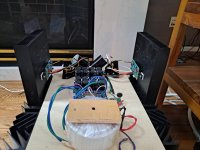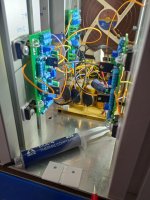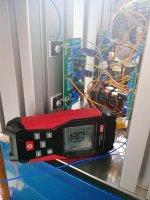at the momment i have not so much, i start to improve my chain
a cd reader philips
a computer
a amplifier NAD c356 BEE
..
i don't see it on the board... the trimmer rest in the building?
trimmer in the basis kit are not enough? (3386P-1-102LF)
does there is a tutorial step by step for the building?
I looked up your NAD integrated amp. Based on the info here (https://nadelectronics.com/wp-conte...tereo-Integrated-Amplifier-English-Manual.pdf) and the fact that you listed two sources, my suggestion is to configure it as a preamp (disconnect PRE OUT 2 from MAIN IN and then wire PRE OUT 2 to the F5m) and use the NAD for source switching and volume control.
I don't believe there is a build guide yet for this project.
The single turn pot Mr Pass listed in the article is fine. With a single turn pot however, the adjustments can be very sensitive and some builders will prefer a multi turn one for that reason.
I suggested to a friend that he use his NAD integrated as a preamp and it worked really well for him, and he used it that way until he eventually upgraded to a Freya.
Does the kit come with multi-turn pots?
Does the kit come with multi-turn pots?
I like to try other output mosfets in this kit. Is it ok if the mosfets are not matched? Like FQA36P15 / FQA28N15 or somebody have better pair to suggest what to try in this kit?
It's not essential to match the fets in this circuit as the bias trimpots will adjust the bias and the DC offset. - NP
is it intresting to put this on the chassis?
https://fr.aliexpress.com/item/4000...cene:pcDetailBottomMoreThisSeller|query_from:
https://fr.aliexpress.com/item/4000...cene:pcDetailBottomMoreThisSeller|query_from:
wich diameter do you advice me to take esthetically on my 3u chassis?
https://fr.aliexpress.com/item/1005...tomMoreThisSeller|query_from:#nav-description
https://fr.aliexpress.com/item/1005...tomMoreThisSeller|query_from:#nav-description
is it intresting to put this on the chassis?
The plug doesn't seem like a bad idea if it fits your chassis, though I'm not sure I'd opt for the 0.99 aliexpress version, I take fire safety pretty serious.wich diameter do you advice me to take esthetically on my 3u chassis?
Big buttons, big buttons all the way. What else ya gonna put on an amp, meters? hehe
Nothing wrong with a good EMI filter. Below is a quality part:
https://www.digikey.com/en/products/detail/schurter-inc/DD12-9111-111/1646888
Keep in mind, I believe you have to purchase the fuse drawer separately.

https://www.digikey.com/en/products/detail/schurter-inc/DD12-9111-111/1646888
Keep in mind, I believe you have to purchase the fuse drawer separately.
Idk where else to post this, so I will post it here. I was gifted a collection of records, many old original issues, that I am slowly, slowly playing my way through. Tonight is Frank Sinatra's Point of No Return, then the Buddy Holly Story, and now Herbie Hancock's Maiden Voyage. The sound is extra-ordinary, with a character I cannot describe. I have no words for the way these old records sound.I think that's part of the character of this amp. It's rather charming playing old records from the 60's-70's where the vocals have some twang to them. It helps to have a bright & forward phono stage like a Pearl 3.
Tonight's magic is courtesy of a modified Rega Planar 3 turntable and an Ortofon 2M Bronze, a Pearl 3 (balanced output), a Pass XP-10, an F5m, and Seas A26 speakers. Maybe a little eclectic as audio chains go, but dang. This is a crazy amazing hobby.
So I built my own Rawson version of this amp and It is deadly! It is simply a test setup. All of this will be tossed into my dads old Aleph clone pretty soon.
I am very impressed with it. It sounds fantastic! Lots of detail and air which is really awesome! I will say, there is something to be said for a simple complimentary JFET pair feeding a couple of tired puppies... I added some 70uF film caps to the final stage of the PS so I could keep... Ahem, "testing" the amp... With my janky setup, there is absolutely no noise coming from the speaker! I can put my ear up to the tweeter and get nothing. I must have grounded the wood properly.
Things are sounding great! Wonderful imaging, lots of mid and high frequency detail, deep soundstage, no grain etc. Smooth but not dark or dull. It isn't the most dynamic amp that I have heard but it is definitely not lacking in dynamics for such a small amp. It isn't lush like an Aleph. The bass is tight but doesn't make a point of itself.. The mids and highs are the focus of this amp. The amp has a sofness to it while not feeling like it is giving up deatil.
You know that an amp is good if you are listening to it quietly at night time. All the noise has settled for the day. Then you close your eyes imagine yourself walking into the music. I think I will "test" this one for a while. I do have a couple of questions:
1) Looking at R5, there seems to be a interesting pad placed in the middle. of the footprint.. I am guessing that this is to turn this into a balanced amp (SUSY?) by not connecting R5 on the ground side but rather feeding it into the middle pad of a 2nd F5m board?
2) I didn't see how the H2 was made. Everything looks very symmetrical. The only thing I can think of is that the careful selection of the IDSS on the pos and neg JFETs produce the neg phase 2nd harmonic distortion. Does this sound right? I have two more kits coming (to play with question #1)
Another experiment that I think would be worth trying is different outputs like maybe some Toshiba mosfets.
I am very impressed with it. It sounds fantastic! Lots of detail and air which is really awesome! I will say, there is something to be said for a simple complimentary JFET pair feeding a couple of tired puppies... I added some 70uF film caps to the final stage of the PS so I could keep... Ahem, "testing" the amp... With my janky setup, there is absolutely no noise coming from the speaker! I can put my ear up to the tweeter and get nothing. I must have grounded the wood properly.
Things are sounding great! Wonderful imaging, lots of mid and high frequency detail, deep soundstage, no grain etc. Smooth but not dark or dull. It isn't the most dynamic amp that I have heard but it is definitely not lacking in dynamics for such a small amp. It isn't lush like an Aleph. The bass is tight but doesn't make a point of itself.. The mids and highs are the focus of this amp. The amp has a sofness to it while not feeling like it is giving up deatil.
You know that an amp is good if you are listening to it quietly at night time. All the noise has settled for the day. Then you close your eyes imagine yourself walking into the music. I think I will "test" this one for a while. I do have a couple of questions:
1) Looking at R5, there seems to be a interesting pad placed in the middle. of the footprint.. I am guessing that this is to turn this into a balanced amp (SUSY?) by not connecting R5 on the ground side but rather feeding it into the middle pad of a 2nd F5m board?
2) I didn't see how the H2 was made. Everything looks very symmetrical. The only thing I can think of is that the careful selection of the IDSS on the pos and neg JFETs produce the neg phase 2nd harmonic distortion. Does this sound right? I have two more kits coming (to play with question #1)
Another experiment that I think would be worth trying is different outputs like maybe some Toshiba mosfets.
Attachments
"Everything looks very symmetrical"
The IRF N and P type MOSFETS have different Ugs, and different transconductance. The input Jfets will have different transconductance. "Complements".... um sure, datasheet says so. Absolute 100% carbon copies of each other, just opposite polarity? Well not quite. Fortunately we have Papa who knows how to mix all this stuff up in the cauldron....
The IRF N and P type MOSFETS have different Ugs, and different transconductance. The input Jfets will have different transconductance. "Complements".... um sure, datasheet says so. Absolute 100% carbon copies of each other, just opposite polarity? Well not quite. Fortunately we have Papa who knows how to mix all this stuff up in the cauldron....
Papa talked a bit about the H2 here:
https://www.diyaudio.com/community/...b-power-amplifier.227503/page-72#post-7627989
https://www.diyaudio.com/community/...b-power-amplifier.227503/page-72#post-7627989
Nice build, where did you get that large PSU board and what size caps can they accommodate?So I built my own Rawson version of this amp and It is deadly! It is simply a test setup. All of this will be tossed into my dads old Aleph clone pretty soon.
Thanks
"Everything looks very symmetrical"
The IRF N and P type MOSFETS have different Ugs, and different transconductance.
Papa talked a bit about the H2 here:
https://www.diyaudio.com/community/...b-power-amplifier.227503/page-72#post-7627989
Ahh, that makes sense. Always interesting to find out where all of the tricks are.
manniraj,
The PSU board is something I drew up a long time ago. It is a CRC cap bank of 16x10,000uF 25v caps. So the cap footprints are 25mm with 10mm snap in lead spacing. The design is not as creative as Pass's with the thermistors but they work well.
The PSU board is something I drew up a long time ago. It is a CRC cap bank of 16x10,000uF 25v caps. So the cap footprints are 25mm with 10mm snap in lead spacing. The design is not as creative as Pass's with the thermistors but they work well.
I've just changed pads and measured temps on one mono block channel to see what difference the ceramic pads would make to the elevated temperatures I was measuring on o/p devices with vertical sinks and fan case (see post 1,888).
I can confirm that the ceramic pads with Arctic MX4 paste have reduced metal tab temps on the devices by 22C, while increased h/sink temps close by devices by 10C. That is quite an impressive improvement, and brings device case temperature back down to reasonable levels.
I hadn't realized how poor the performance of silicon tabs could be at these power levels.
Thank you very much to Mikerodrig27 for the recommendation in his post #1,899 ! Now I've got to do the other channel today.
I can confirm that the ceramic pads with Arctic MX4 paste have reduced metal tab temps on the devices by 22C, while increased h/sink temps close by devices by 10C. That is quite an impressive improvement, and brings device case temperature back down to reasonable levels.
I hadn't realized how poor the performance of silicon tabs could be at these power levels.
Thank you very much to Mikerodrig27 for the recommendation in his post #1,899 ! Now I've got to do the other channel today.
Attachments
Any comparison with the Keratherm pads vs. the Aavid / Arctic MX-4? I see there is also a MX-6 product that claims "20% lower thermal resistance" Would it be better?
I'm using a thermocouple contact probe & meter. I'm touching the probe from above onto the exposed metal back of the devices. In this photo attached the metal tab is measuring 68.1C and ambient temp is 32C at bias of 0.8A and +-27V rails, the amps is outside here after swapping to ceramic pads, so it's probably benefiting from a little extra airflow in the breeze.
Attachments
I wanted to also ask what you think the temperature of the metal back should be as 1-reasonable, 2-high and 3 -too high ?
I got the recommendation for the insulators I believe from Tungsten audio. The thermal goop was just research looking for decent bang for the buck.
I had a couple of mica insulators fail to insulate which was part of the decision for me to switch to these ceramic insulators. Now I don't have to worry about it.
I am surprised at the performance of the ones that came with the kit. I wonder if there was an issue with them.
I had a couple of mica insulators fail to insulate which was part of the decision for me to switch to these ceramic insulators. Now I don't have to worry about it.
I am surprised at the performance of the ones that came with the kit. I wonder if there was an issue with them.
- Home
- Amplifiers
- Pass Labs
- F5m kit



